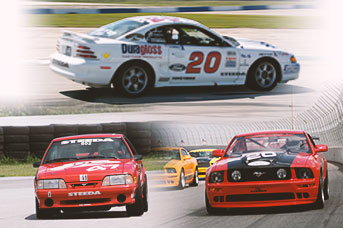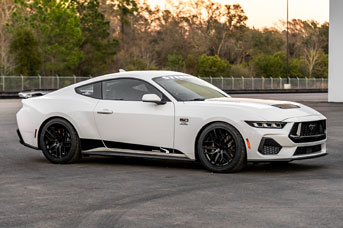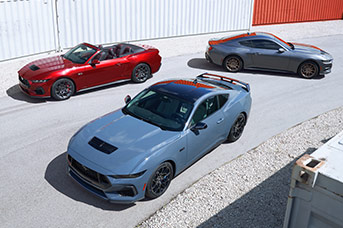The 2024 Steeda Q500: An Overview

Table of Contents
Seeking to unlock the S650's performance potential, Steeda got to work with a new project vehicle, the 2024 Mustang GT HPDE. The car is a rolling laboratory, showcasing the new platform’s potential while providing valuable data for ongoing S650 product development.
The effort is based on a 2024 Mustang GT with the latest (Gen 4) 5.0L Coyote V8, a six-speed MT-82 manual transmission, and the Performance Package. Steeda deliberately chose this configuration, representing a popular mainstream choice among enthusiasts and a solid base for modifications. Other S650 project cars, the 2024 Steeda Dark Horse Mustang 2024 Steeda Dark Horse Mustang and the 2024 Steeda Mustang Silver Bullet 2.0 drag car, take different directions.
Baseline Performance
To establish a performance benchmark, Steeda's Vice President of Operations, Glen Vitale, took the bone-stock Mustang GT to Florida’s Sebring International Raceway. The initial lap time of 2:30 reinforced the out-of-the-box capabilities of an S650 Mustang GT and matched the time set by Steeda's fully modified Q350 EcoBoost Handling Build.
Stage 1 Modifications
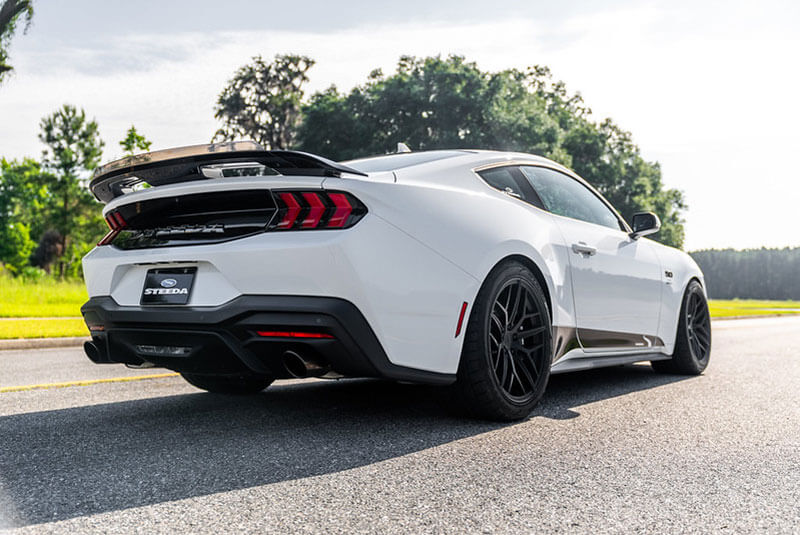
With baseline performance established, and Stage 1 modifications in place, the Mustang returned to Sebring and produced a 2:28.5 lap time, an improvement of 1.5 seconds over stock. These steps laid the groundwork for the next phase, which focused on power enhancements
-
Suspension: Project engineers installed Steeda Dual Rate Ultimate Handling Springs, Pro-Action adjustable shocks and struts, and front and rear adjustable sway bars. These components work together to improve cornering stability and body control.
-
Chassis Reinforcement: To stiffen up the chassis in the S650, a modification included an Ultralite 2-Point G-Trac brace and a Steeda 'Stop the Hop' Street Starter Kit, comprised of IRS subframe support braces, a subframe bushing support system, and a subframe alignment kit.
-
Exhaust: A Steeda 3" cat-back exhaust system in 304 stainless steel was fitted to improve exhaust flow and add a more aggressive sound.
-
Alignment: A Steeda performance alignment was performed to optimize the car's handling characteristics for track use.
Stage 2 Modifications
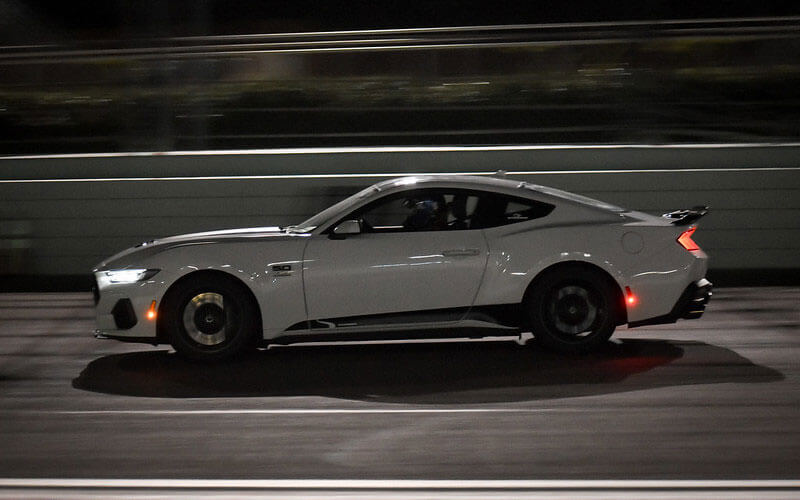
With the Stage 2 modifications complete, the Mustang returned to Sebring for another round of testing. The improvements were dramatic, with the lap time dropping to 2:23.6—6.4 seconds faster than the stock configuration and 4.9 seconds quicker than the Stage 1 build.
It's worth noting that these gains were achieved without any significant changes to the Gen 4 Coyote V8. The powerplant remains unchanged internally, with the original tune and using 93-octane fuel.
-
Drivetrain: A Steeda 3.5" 1350 Series aluminum driveshaft was installed to handle increased power and provide smoother power delivery. The MT-82 gearbox received Steeda's Tri-Ax Race Short Throw Shifter for more precise gear changes, and we installed Kooks Long Tube Headers to help us gain HP and it ended up being a key component in our improved lap time.
-
Suspension: Building on the Stage 1 upgrades, the team added Steeda Pro-Action adjustable rear shocks with billet rear shock mounts. The front suspension was upgraded to Pro-Action coilovers, while the rear received an adjustable ride height kit. Spring rates were significantly increased, with 400-lb springs in the front and a 1,100-lb Hyperco set in the rear.
-
Chassis: Steeda's Road Race front K-member with G-Trac brace was installed, further improving chassis rigidity and suspension geometry. A Steeda bumpsteer kit was also added to maintain proper steering characteristics regardless of suspension travel.
-
Brakes: Steeda Custom Hawk DTC70 front brake pads were fitted to improve stopping power and resist fading during extended track sessions.
-
Wheels and Tires: Perhaps one of the most noticeable changes came from Steeda's Trident satin black 19x11 wheels, wrapped in Yokohama ADVAN A052 tires in a 295/35R19 size. This setup provides a larger contact patch than the stock wheels and tires, increasing cornering and braking grip.
-
Weight Reduction: A rear seat delete kit was installed, and the passenger seat was removed for the second effort. Combined with the lighter suspension components, these changes resulted in a substantial 200-pound weight reduction compared to the Stage 1 build.
Looking Ahead
While the 2:23.6 lap time is impressive, the Steeda team is far from finished with this project. The next logical step would be to extract more power from the Coyote V8 via a custom tune or by making intake and exhaust modifications. Given that the engine is still running a stock tune, there's likely significant potential waiting to be had once tuning becomes available. Vitale echoes these thoughts as he’s eager to challenge Porsche 911s and Corvettes on the straights.
Additionally, as more S650 Mustangs reach customers, Steeda will undoubtedly use the data and experience gained from this project to refine its product offerings and introduce new ones.
Research and Development Takeaways
Steeda’s systematic approach to testing and validation ensures its parts deliver what they promise. By starting with a stock vehicle and progressively adding modifications, engineers can isolate the effects of change and measure the improvements. This comes to life in track performance.
But testing often uncovers the unexpected. Sebring International Raceway is known for its uneven track surface and mix of high-speed straights and technical corners. It’s a challenging setting that often tests a vehicle’s capabilities.
In the case of the Steeda 2024 Mustang GT HPDE, Sebring caused tire rubbing issues, which led to an on-the-spot adjustment: a slightly raised ride height. Such real-world testing allows Steeda to anticipate and address potential problems before their customers encounter them.
Steeda's Racing Heritage: Four Project Cars That Shaped Ford Performance
For over 35 years, Steeda has been pushing the boundaries of Ford performance. It’s all part of an ongoing development process to ensure every Steeda part is ready for the street and track. While industrial testing ensures these components meet manufacturing standards, there’s no substitute for using them in real-world racing scenarios. Over the decades, Steeda has built several rolling test beds that affirm this principle. Here are four of the most notable Steeda project cars.
Steeda 2001 Q400: The Supercharged New Edge
This supercharged beast from the early 00’s has become an important vehicle in the Steeda stable. With nearly 400-horsepower, this Mustang tore up the track and street. Living life with a Paxton NOVI-2000 Supercharger, it comes equipped with a number of Steeda suspension and powertrain upgrades to give this 2V Mustang enough to compete with present-day Mustangs. These upgrades include the famed Steeda Mustang 5-Link Rear Suspension System that helped Ed Hosni and Tom Ellis win multiple SCCA National Championships and NASA wins. This Mustang serves as a reminder that Steeda are the experts for all Fox platform Mustangs.
Steeda 2005 Ol' Yellow: The Streetable Monster
On the street side, there’s Ol' Yellow, a pre-production 2005 Mustang that Steeda turned into an absolute monster. While there’s a venerable 4.6L under the hood, this powerplant incorporates numerous upgrades, including a Steeda Custom Cold Air Intake and a Whipple supercharger. It all adds to more than 600-wheel horsepower. But don’t just think of Ol’ Yellow as only a straight-line hero; it’s equally capable of ripping through corners. What makes this Mustang especially noteworthy is that Steeda still uses it to test S197 components, underscoring the viability of this Mustang generation for racers and enthusiasts.
Steeda 2018 Silver Bullet: The Naturally Aspirated Record-Breaker
Before the 2018 Steeda Silver Bullet received its Edelbrock Supercharger, it was known as the fastest naturally aspirated mustang on the planet. A fitting achievement given its nickname. The team at Steeda was able to take the bone-stock car from 12s in the quarter mile, all the way down to a mind-boggling record breaking 9.76 ET at 143 MPH with the help of numerous upgrades. These upgrades include front and rear Baer lightweight drag 4-piston brake systems, Steeda Front Coilovers, Steeda Rear Drag Springs, Steeda IRS Subframe Braces, and more Steeda suspension components.
Steeda S550 Yellow #20: The Modern Track Star
Last but not least, there's the S550 Yellow #20, Steeda's latest track weapon based on the sixth-gen Mustang. This started life as a vanilla 2015 GT before Steeda practically threw their entire catalog at it. The most significant change began in the engine bay, as the stock Coyote V8 was swapped for a Ford Performance 5.2L Aluminator XS crate engine. Meanwhile, the aero package has gotten progressively more aggressive via a massive APR rear wing and other exterior goodies. All the effort paid off as Yellow #20 took home the 2018 SARRC championship.
These four cars are just the tip of the iceberg; check out all the Steeda project vehicles and let your imagination run wild. Whether you're into a Mustang, Focus, or anything else wearing a Blue Oval, chances are Steeda's got something cooking that'll make your ride just a little bit quicker.


